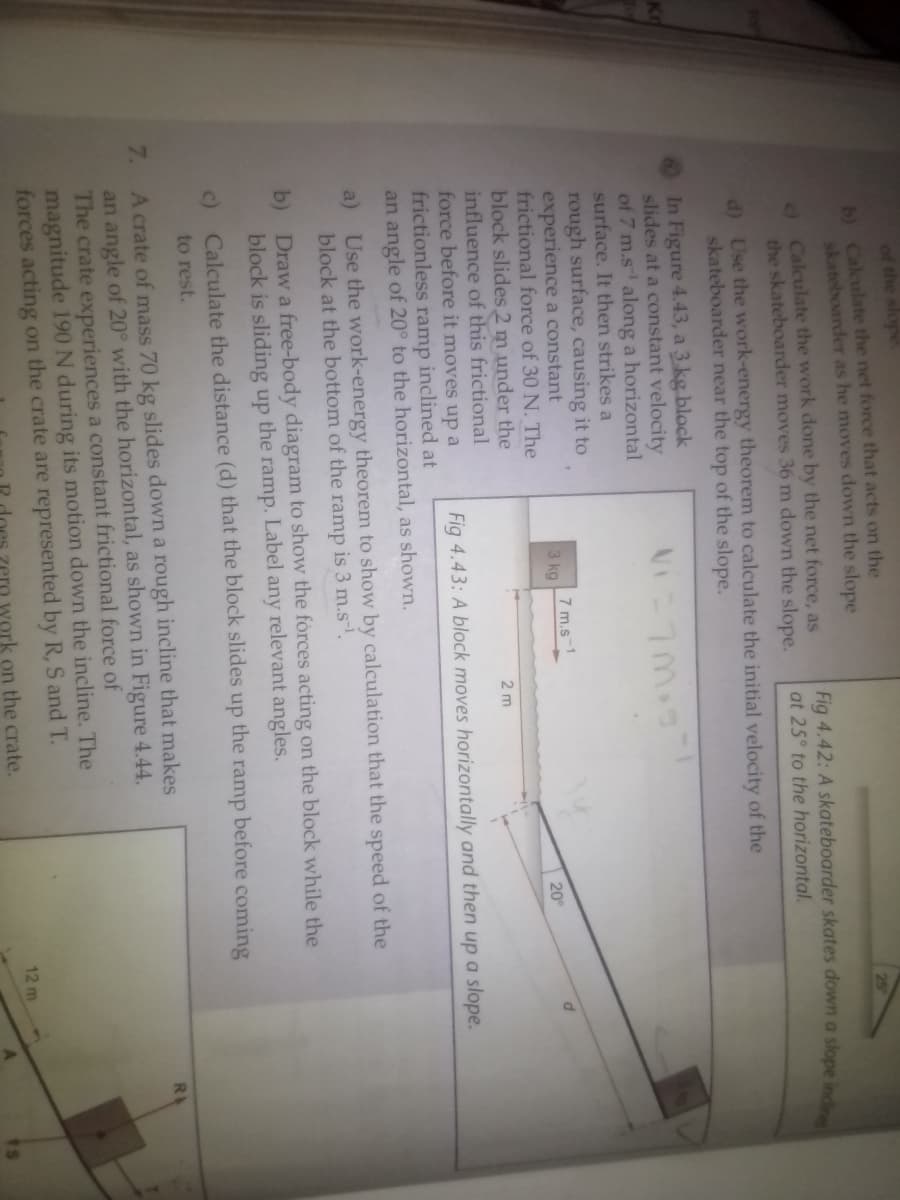In Figure 4.43, a 3 kg block slides at a constant velocity of 7 m.s along a horizontal surface. It then strikes a rough surface, causing it to experience a constant frictional force of 30 N. The block slides 2 m under the influence of this frictional force before it moves up a frictionless ramp inclined at an angle of 20° to the horizontal, as shown. 7 m.s-1 3 kg 20 2 m Fig 4.43: A block moves horizontally and then up a slc a) Use the work-energy theorem to show by calculation that the speed of the block at the bottom of the ramp is 3 m.s- b) Draw a free-body diagram to show the forces acting on the block while the block is sliding up the ramp. any relevant angles. c) Calculate the distance (d) that the block slides up the ramp before coming
In Figure 4.43, a 3 kg block slides at a constant velocity of 7 m.s along a horizontal surface. It then strikes a rough surface, causing it to experience a constant frictional force of 30 N. The block slides 2 m under the influence of this frictional force before it moves up a frictionless ramp inclined at an angle of 20° to the horizontal, as shown. 7 m.s-1 3 kg 20 2 m Fig 4.43: A block moves horizontally and then up a slc a) Use the work-energy theorem to show by calculation that the speed of the block at the bottom of the ramp is 3 m.s- b) Draw a free-body diagram to show the forces acting on the block while the block is sliding up the ramp. any relevant angles. c) Calculate the distance (d) that the block slides up the ramp before coming
Refrigeration and Air Conditioning Technology (MindTap Course List)
8th Edition
ISBN:9781305578296
Author:John Tomczyk, Eugene Silberstein, Bill Whitman, Bill Johnson
Publisher:John Tomczyk, Eugene Silberstein, Bill Whitman, Bill Johnson
Chapter2: Matter And Energy
Section: Chapter Questions
Problem 21RQ
Related questions
Question

Transcribed Image Text:of the slope.
b) Calkulate the net force that acts on the
skateboarder as he moves down the slope
a Calculate the work done by the net force, as
the skateboarder moves 36 m down the slope.
Fig 4.42: A skateboarder skates down a slope ind
at 25° to the horizontal.
d) Use the work-energy theorem to calculate the initial velocity of the
skateboarder near the top of the slope.
In Figure 4.43, a 3 kg block
slides at a constant velocity
of 7 m.s along a horizontal
surface. It then strikes a
rough surface, causing it to
experience a constant
frictional force of 30 N. The
block slides 2 m under the
influence of this frictional
force before it moves up a
frictionless ramp inclined at
an angle of 20° to the horizontal, as shown.
7 m,s-1
3 kg
of
20
2 m
Fig 4.43: A block moves horizontally and then up a slope.
a) Use the work-energy theorem to show by calculation that the speed of the
block at the bottom of the ramp is 3 m.s-.
b) Draw a free-body diagram to show the fòrces acting on the block while the
block is sliding up the ramp.
Label
any
relevant angles.
) Calculate the distance (d) that the block slides up the ramp before coming
to rest.
A crate of mass 70 kg slides down a rough incline that makes
an angle of 20° with the horizontal, as shown in Figure 4.44.
The crate experiences a constant frictional force of
magnitude 190 N during its motion down the incline. The
forces acting on the crate are represented by R, S and T.
7.
work on the crate.
12 m
ts
Expert Solution
This question has been solved!
Explore an expertly crafted, step-by-step solution for a thorough understanding of key concepts.
This is a popular solution!
Trending now
This is a popular solution!
Step by step
Solved in 2 steps with 1 images

Knowledge Booster
Learn more about
Need a deep-dive on the concept behind this application? Look no further. Learn more about this topic, mechanical-engineering and related others by exploring similar questions and additional content below.Recommended textbooks for you

Refrigeration and Air Conditioning Technology (Mi…
Mechanical Engineering
ISBN:
9781305578296
Author:
John Tomczyk, Eugene Silberstein, Bill Whitman, Bill Johnson
Publisher:
Cengage Learning

Refrigeration and Air Conditioning Technology (Mi…
Mechanical Engineering
ISBN:
9781305578296
Author:
John Tomczyk, Eugene Silberstein, Bill Whitman, Bill Johnson
Publisher:
Cengage Learning